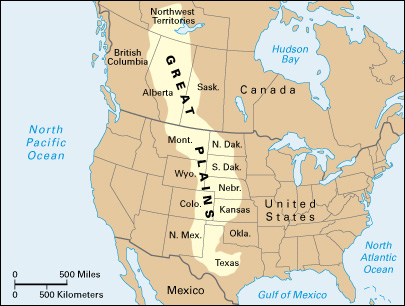Great Plains is a vast, dry grassland in North America. It is an important agricultural and mining region. The Great Plains extends for about 2,500 miles (4,020 kilometers) from northern Canada into New Mexico and Texas in the United States. It stretches eastward for about 400 miles (640 kilometers), from the Rocky Mountains to western Saskatchewan in Canada; and to eastern South Dakota, Nebraska, Kansas, and Oklahoma in the United States. The western boundary along the mountain front is from 4,500 to 6,500 feet (1,370 to 1,980 meters) high. The eastern boundary is from 1,500 to 2,000 feet (457 to 610 meters) high. Major rivers include the Arkansas, Canadian, Missouri, Platte, and Saskatchewan.

Relatively few people live in the western Great Plains. The region’s population increases toward the east.
The Great Plains supports much plant and animal life. It has a variety of grasses, including blue grama, buffalo grass, crested wheatgrass, and little bluestem. Animals of the region include lizards, opossums, prairie dogs, weasels, raccoons, rattlesnakes, and skunks.
Agriculture and mining dominate the economy. The Great Plains is one of the world’s chief wheat-growing areas. Other farm products include alfalfa, barley, oats, and rye. Cattle, goats, and sheep graze there. The Great Plains yields more oil than any other area of the United States or Canada. The north has huge coal deposits.
Indians were the first inhabitants of the Great Plains. Spaniards became the first Europeans to explore the area, in the 1500’s. The French began a fur trade with Indians of the region in the 1700’s. After the Civil War in the United States (1861-1865), railroads that were built westward across the Great Plains led to the establishment of new towns and farming and ranching areas. Large deposits of petroleum and natural gas were discovered in the region in the 1920’s. Since World War II (1939-1945), petroleum and coal mining have contributed to the region’s prosperity.
